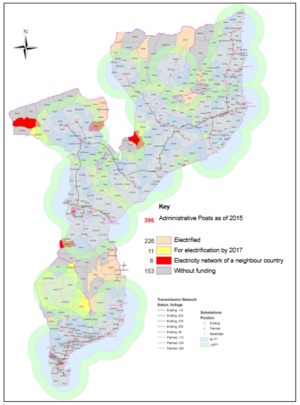Knowledge fuels change - Support energypedia!
For over 10 years, energypedia has been connecting energy experts around the world — helping them share knowledge, learn from each other, and accelerate the global energy transition.
Today, we ask for your support to keep this platform free and accessible to all.
Even a small contribution makes a big difference! If just 10–20% of our 60,000+ monthly visitors donated the equivalent of a cup of coffee — €5 — Energypedia would be fully funded for a whole year.
Is the knowledge you’ve gained through Energypedia this year worth €5 or more?
Your donation keeps the platform running, helps us create new knowledge products, and contributes directly to achieving SDG 7.
Thank you for your support, your donation, big or small, truly matters!
Grid Interconnection for Mini-grids in Mozambique
Introduction
This article provides an overview of policy and regulatory framework for grid interconnection in Mozambique and is targeted at private sector, donor organisations, NGOs, Government bodies and other stakeholders who are interested in getting a deeper understanding of the nano/mini-grid market in Mozambique.
For an overview of the stakeholders involved in the market, click here.
For an overview of the market size and potential growth, click here.
For an overview of the policy and regulatory framework, click here.
Grid Interconnection
The new Regulation for Energy Access in Off-Grid Areas (approved by Decree n. °93/2021) has the following provisions for grid interconnection of mini-grids:
- "In case, the national grid is planned to reach the mini-grid concession area, the manager of the national electricity grid and the person responsible for the national grid expansion, must previously notify the Energy Regulatory Authority and the affected concessionaire(s), including the interconnection proposal or not, of the respective mini-grid production or distribution facilities, under the conditions mentioned in number 3 of Article 22.
- In cases of interconnection to the national grid, the mini-grid should comply with the Grid Code and other technical standards that are applicable for the national grid."
For grid interconnection, it also includes the different alternatives:
- "preservation of the mini-grid concession without interconnection;
- interconnection to the national electricity grid with preservation of the mini-grid concession, allowing the mini-grid concessionaire to purchase energy from the electricity distribution network concessionaire;
- interconnection to the national grid with the conversion of the mini-grid concession into a concession for production, allowing the mini-grid concessionaire to sell energy to the distribution network concessionaire and to transfer the mini-grid infrastructure, as well as the commercialization activity of the mini-grid to the electricity distribution network concessionaire;
- interconnection to the national electricity grid with termination of the mini-grid concession and subcontracting its concessionaire for the management and operation of the activities of distribution and commercialization of electricity;
- interconnection to the national grid, with termination of the concession and total transfer of activities and electrical infrastructures and installations that are part of the mini-grid to the concessionaire of the national distribution grid or another public entity to be indicated."
In case of mini-grid termination, the financial compensation for the mini-grid operator is mentioned in the number 7 of article 15 of this regulation[1].
The new electricity law, Law no. 12/2022 establishes that "In the case of the interconnection of the mini-grid to the National Electricity National Electricity Grid, the extinction of the respective concession is subject to the regime defined in the regulation"[2].
Currently, only the proposed grid extension plan is available (figure below) but their grid arrival schedule is not available[3].
The following large-scale projects will be an addition of the National Grid and therefore an important consideration for mini-grids planned in surrounding areas.
Planned large-scaled plants for evolution of installed capacity:
- Mphanda Nkuwa Hydropower plant, the most structuring investment, which would add 1,500 MW of generation capacity.
- The construction of the 50 MW Tsate Hydropower plant to be commissioned by 2025
- The renewable energy auctions program (PROLER), which will provide a cumulative 130 MW solar and wind capacity (3x30 MW solar + 40 MW wind)
- The Temane Combined Cycle Gas Project, a 450 MW gas-fired power project
- GET.fit program will provide 3x15 MW capacity
- Cuamba (Globetech/Alten/ABP) 30 MW PV power plant to be commissioned in 2022
- Cuamba (Globeleq/Source Energy) 15 MW PV power plant with storage to be commissioned in 2022
- Mecufi (MBHE and Moz Energy) 20 MW PV power plant to be commissioned in 2022
Planned expansion of the transmission network:
- 400 kV High Voltage Transmissison Line Chimura – Nacala (Phase II)
- 110 kV High Voltage Transmissison Line Nampula – Angoche
- 400kV High Voltage Transmissison Line Songo - Matambo – (Phase II)
- 400kV Tanzania interconnector
- 400kV 218km High Voltage Transmission Line from Tete to Malawi
- 400kV 560 High Voltage Transmission Line, Temane - Maputo
Further Information
References
- ↑ Decreto-NÂo-93-2021-de-10-de-Dezembro-de-2021-Aprova-o-Regulamento-de-Acesso-Ã-Energia-Nas-Zonas-Fora-Da-Rede.Pdf’. Accessed 19 January 2022. https://amer.org.mz/wp-content/uploads/2021/12/Decreto-nA%CC%82o-93-2021-de-10-de-Dezembro-de-2021-Aprova-o-Regulamento-de-Acesso-A%CC%83-Energia-nas-Zonas-Fora-da-Rede.pdf.’.
- ↑ Lei n.º 12/2022 - Lei de Electricidade e revoga a Lei n.º 21/97, de 1 de Outubro, https://www.lerenovaveis.org/contents/lerpublication/lei-12_2022-lei-de-electricidade.pdf
- ↑ SEforALL Africa Hub. ‘Green Mini Grid Market Development Programme’, 2017. https://www.aler-renovaveis.org/contents/lerpublication/afdb_2017_abr_mini-grid-market-opportunity-assessment-mozambique.pdf.




















